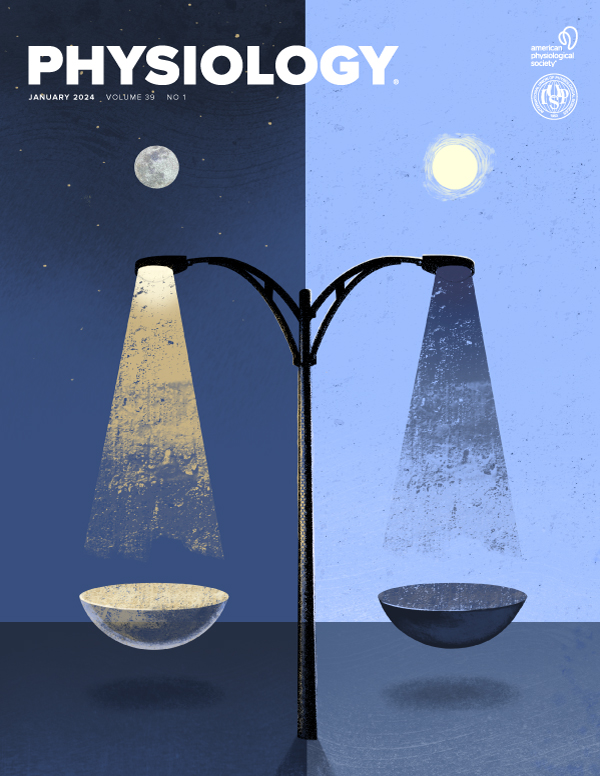正常血压成人急性运动后交感神经血管转导增强
IF 5.3
2区 医学
Q1 PHYSIOLOGY
引用次数: 0
摘要
在血压正常的成年人中,急性一次有氧运动对交感神经血管相互作用的影响尚不清楚。先前的药理研究表明α-肾上腺素能受体的敏感性没有变化,然而,闭环条件下的评估尚未进行。当前研究的目的是评估正常血压成人急性运动后的交感神经血管转导。我们假设急性运动将减少交感神经血管传导。方法:采用随机交叉设计,8名年轻健康参与者(4名女性)分别进行:1)以60%最大VO2max进行60分钟的自行车运动,或2)60分钟的坐着对照,间隔至少1个月。两种干预措施后90分钟,在仰卧位进行10分钟的神经心血管评估。搏动心率(心电图)、血压(手指光波脉搏图)、肌肉交感神经活动(MSNA);腓骨神经微神经造影)和股浅动脉血流(双工超声)量化;以血流量/平均动脉压计算股血管传导(FVC)。使用信号平均技术量化交感-FVC转导,其中FVC对每次MSNA爆发的反应在15个心脏周期内被连续跟踪,并平均得出FVC的最低点变化。最后,在对照访问中进行测量后,一部分参与者(n=4)将下肢浸入40°C的水中,达到内踝的水平,以评估皮肤血流量急性增加后的交感神经- fvc转导。结果:与对照组相比,运动后心率(60±8 vs 66±8次/min)、股浅动脉血流(68±25 vs 104±42 mL/min)、股血管电导(0.9±0.3 vs 1.4±0.5 mL/min/mmHg)升高(P均<0.02),平均动脉压(76±4 vs 78±7 mmHg)升高;P=0.41)和MSNA爆发频率(18±6比18±5次/min);P=0.85)差异无统计学意义。运动增加了交感神经爆发后FVC的减少(-0.12±0.04 vs -0.17±0.06 mL/min/mmHg);P = 0.04)。运动后FVC增加越多,交感-FVC转导增加的幅度越大(r=-0.65;P = 0.08)。然而,下肢加热后FVC增加(0.9±0.3 vs. 2.1 mL/min/mmHg;P<0.01)与交感- fvc转导的平行变化无关(-0.07±0.04 vs -0.07±0.04 mL/min/mmHg;P = 0.92)。结论:有氧运动后交感- fvc转导急剧升高,这与运动后血管舒张的程度有关。考虑到在下肢加热过程中交感神经- fvc转导没有变化,这些初步观察结果表明,交感神经血管转导的增强是由血流无关的机制促进的。本研究得到了加拿大自然科学与工程研究委员会(NSERC)的发现基金(pj.m)和加拿大卫生研究院弗雷德里克·班廷和查尔斯·贝斯特加拿大研究生奖学金(M.N)的支持。这是在2023年美国生理学峰会上发表的完整摘要,仅以HTML格式提供。此摘要没有附加版本或附加内容。生理学没有参与同行评议过程。本文章由计算机程序翻译,如有差异,请以英文原文为准。
Augmented sympathetic neurovascular transduction following acute exercise in normotensive adults
Introduction: The effects of an acute bout of aerobic exercise on sympathetic neurovascular interactions in normotensive adults remain unclear. Pharmacological work has previously demonstrated unchanged α-adrenergic receptor sensitivity, however, assessments under closed-loop conditions have not been conducted. The objective of the current study is to evaluate sympathetic neurovascular transduction following acute exercise in normotensive adults. We hypothesize that acute exercise will decrease sympathetic neurovascular transduction. Methods: Using a randomized cross-over design, eight young healthy participants (four female) performed either: 1) 60 minutes of cycling exercise at 60% VO2max, or 2) 60 minutes of a seated control, separated by a minimum of 1-month. Ninety minutes following both interventions, a 10-minute neuro-cardiovascular assessment was preformed in the supine position. Beat-to-beat heart rate (electrocardiography), blood pressure (finger photoplethysmography), muscle sympathetic nerve activity (MSNA; fibular nerve microneurography), and superficial femoral artery blood flow (Duplex ultrasound) were quantified; femoral vascular conductance (FVC) was calculated as blood flow/mean arterial pressure. Sympathetic-FVC transduction was quantified using the signal-averaging technique, whereby FVC responses to each MSNA burst were serially tracked over 15 cardiac cycles and averaged to derive the nadir change in FVC. Lastly, following measurements performed on the control visit, a subset of participants (n=4) submerged the lower limb into 40°C water to the level of the malleolus, to assess sympathetic-FVC transduction following acute increases in skin blood flow. Results: Compared to control, heart rate (60±8 vs. 66±8 beats/min), superficial femoral artery blood flow (68±25 vs. 104±42 mL/min), and femoral vascular conductance (0.9±0.3 vs. 1.4±0.5 mL/min/mmHg) were elevated following exercise (all P<0.02), while mean arterial pressure (76±4 vs. 78±7 mmHg; P=0.41) and MSNA burst frequency (18±6 vs. 18±5 bursts/min; P=0.85) were not different. The reduction in FVC following a sympathetic burst was increased following exercise (-0.12±0.04 vs. -0.17±0.06 mL/min/mmHg; P=0.04). A greater increase in FVC following exercise was associated with greater magnitude increase in sympathetic-FVC transduction (r=-0.65; P=0.08). However, the increase in FVC following lower limb heating (0.9±0.3 vs. 2.1 mL/min/mmHg; P<0.01) was not associated with parallel changes in sympathetic-FVC transduction (-0.07±0.04 vs. -0.07±0.04 mL/min/mmHg; P=0.92). Conclusion: Sympathetic-FVC transduction is acutely elevated following aerobic exercise, which was associated with the magnitude of post-exercise vasodilation. Considering that sympathetic-FVC transduction was unchanged during lower limb heating, these preliminary observations suggest that augmented sympathetic neurovascular transduction is facilitated by a blood flow-independent mechanism. This research was supported by a Natural Science and Engineering Research Council (NSERC) of Canada Discovery Grant (P.J.M) and a Canadian Institutes of Health Research Fredrick Banting and Charles Best Canada Graduate Scholarship (M.N). This is the full abstract presented at the American Physiology Summit 2023 meeting and is only available in HTML format. There are no additional versions or additional content available for this abstract. Physiology was not involved in the peer review process.
求助全文
通过发布文献求助,成功后即可免费获取论文全文。
去求助
来源期刊

Physiology
医学-生理学
CiteScore
14.50
自引率
0.00%
发文量
37
期刊介绍:
Physiology journal features meticulously crafted review articles penned by esteemed leaders in their respective fields. These articles undergo rigorous peer review and showcase the forefront of cutting-edge advances across various domains of physiology. Our Editorial Board, comprised of distinguished leaders in the broad spectrum of physiology, convenes annually to deliberate and recommend pioneering topics for review articles, as well as select the most suitable scientists to author these articles. Join us in exploring the forefront of physiological research and innovation.
 求助内容:
求助内容: 应助结果提醒方式:
应助结果提醒方式:


